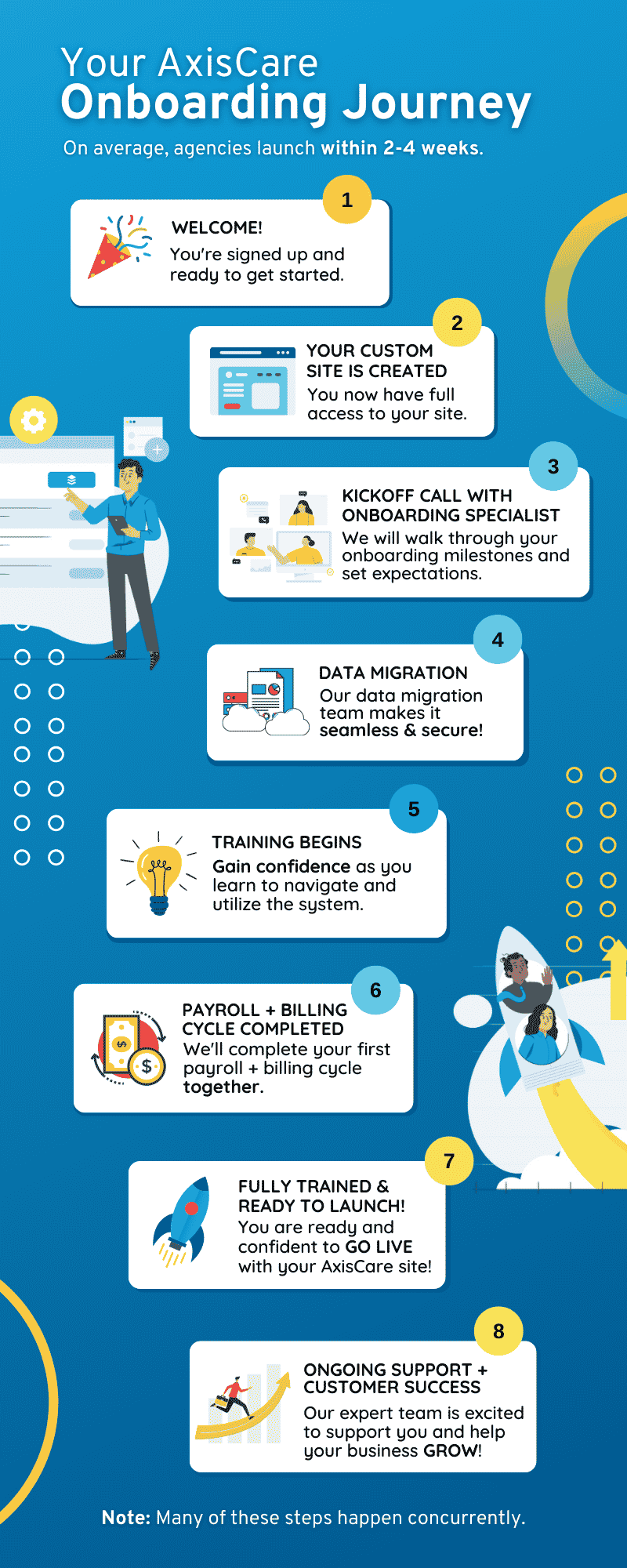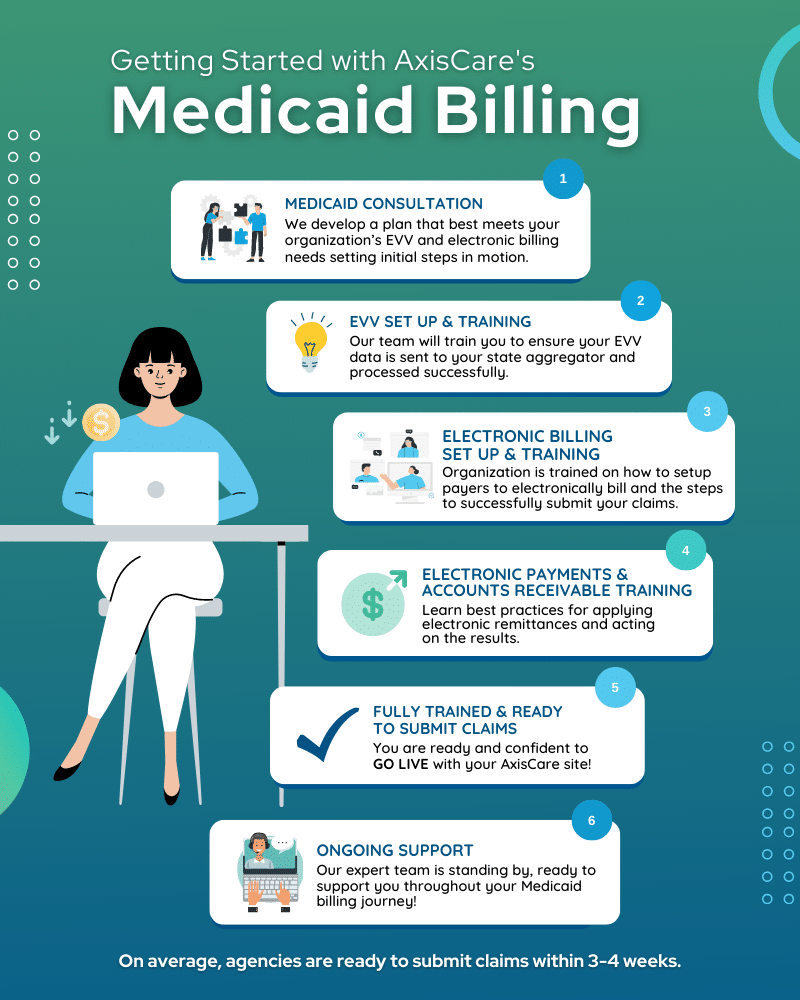Best Practices for EVV Implementation & Training
Electronic Visit Verification (EVV) is fast becoming standard practice for home care agencies across the United States; its use was mandated in the 2016 CURES Act for any Medicaid-funded personal care and home health services delivered at the patient’s residence.
Though many home care providers have no choice but to use EVV, that shouldn’t discount the fact that its benefits speak for themselves. True to its name, this system verifies visits using GPS data captured at the visit: it’s an airtight way to confirm that services are delivered to patients on time and in full and then billed correctly to the insurance provider or client.
Whether it’s required or adopted by choice, implementing EVV can come with its share of challenges – as is the case with any new “way of doing.”
Caregivers and staff may be apprehensive about learning an unfamiliar workflow, and less tech-savvy employees may experience difficulties adapting to a more digital-forward approach. EVV also adds steps to the caregiving process, which may be misinterpreted as extra work at the outset; it’s important for staff to understand that it will actually save them time in the long run.
This article will be your blueprint for understanding EVV and successfully incorporating it into your home care agency.
Understanding EVV Requirements
The use of EVV as per the CURES Act aims to increase caregiver accountability, mitigate fraud, and improve the quality of care received by patients. All of this is made possible by technology that tracks visits and requires caregivers to input specific information.
To comply with the rules set out for Medicaid-funded services, caregivers must log the following information for every appointment:
- Name of patient receiving service
- Date of service
- Location of service delivery
- Individual providing care
- Start and end time of visit
While EVV is federally mandated, states have chosen to implement the system in different ways. There are two frameworks at play:
In an open model state, providers are given the freedom to choose from a range of approved EVV systems. This approach encourages companies to innovate in the EVV space while allowing agencies to select systems that best suit their operational needs.
In a closed model state, all providers must use the same standardized EVV system. This centralized approach aims to simplify the implementation process, promote uniform reporting, and ensure consistency across the state’s healthcare services.
The Challenges of Implementing EVV
The best way to overcome EVV implementation issues is to anticipate them in the first place. As you begin to map out the journey ahead, consider these challenges:
- Your EVV system should play nicely with your existing software ecosystem. Interoperability is a must if you want to reduce friction within your workflow instead of adding extra steps, like inputting the same information twice.
- Like all medical information, the data collected using EVV is sensitive and must be kept private and HIPAA compliant. Make sure your provider has the necessary security measures in place, including data encryption.
- Your staff may be apprehensive about switching up their workflow. People tend to get comfortable with the usual way of doing things; you will likely need to win their buy-in with plenty of training and education, demonstrating the value of this new technology.
- The team behind your EVV software should be ready to provide whatever support you need to make the rollout a success. Without their help and experience, implementation may be a bumpier road than necessary.
- This goes without saying, but your chosen solution should comply with all federal and state-level requirements that regulate the use of EVV.
Developing an Implementation Strategy for EVV
So, how does EVV work in home care given all of these challenges? It all starts with an airtight rollout strategy. To start, draw up a timeline for implementation: realistically, from finding a vendor to completing staff training, how long might it take to get your new system up and running? Setting reasonable milestones will help keep the entire implementation team – which should be created at the outset of the project – accountable.
This team should appoint key stakeholders who are comfortable with advocating for and driving change. Coordination is key and employees are sure to have questions, so clear communication channels should be established within the team itself as well as the company at large.
How to Train Staff on EVV Usage
Getting your entire staff up to speed can be boiled down to a few key steps
Caregiver Training
Start by educating your on-the-ground staff; they will be the ones interacting most frequently with your new EVV system. Caregiver training should include hands-on practice with EVV devices and mobile apps, getting them familiar with the user interface and all of the features at their disposal. Make sure to walk caregivers through common scenarios and provide troubleshooting tutorials.
Administrative Staff Training
Your in-office admin team will need to understand how to manage EVV data, use it to generate reports, handle exceptions, and perform manual data entry to resolve any discrepancies. They should also be trained on compliance requirements to ensure proper documentation and reporting for Medicaid and insurance billing purposes.
Ensuring Data Privacy & Security
As an agency operating in the healthcare space, your employees likely already understand the importance of data privacy and security. While implementing EVV, make sure they brush up on their knowledge of implementing secure data transmission protocols and remaining in compliance with HIPAA while using this new system.
Implementing EVV: Best Practices for Rollout
A phased approach is often the most effective type of rollout for home care agencies. This process involves gradually implementing the system across different departments or geographical areas, facilitating a smoother transition with minimal disruptions and plenty of leeway to iron out snags as they arise.
It’s crucial to give staff and caregivers plenty of support as they become familiar with the EVV system in a real-world setting. Clear communication and well-documented processes can help prevent common issues and address any others as they happen.
Ongoing Compliance & Quality Assurance
With an eye toward long-term success, you will need to monitor and adjust how the EVV system is used. Regularly reviewing the system’s performance, collecting feedback from staff, conducting ongoing audits, and analyzing usage data can reveal opportunities for improvement; by remaining proactive and making the necessary adjustments, agencies can make the most of their new solution while minimizing operational disruptions.
Simplify Your EVV Home Care Management With AxisCare
Time to implement your own EVV solution? Make sure you partner with a provider that knows the ins and outs of every step. Request a live demo with AxisCare to find out how we can make your rollout a resounding success.









